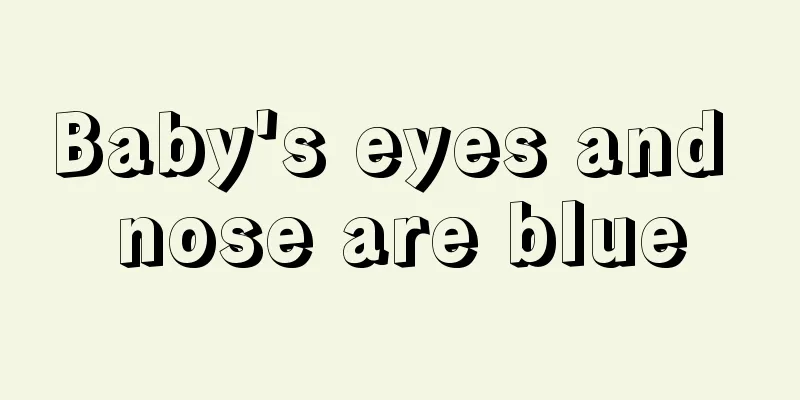Will neonatal jaundice cause drowsiness?

|
Neonatal jaundice is mainly divided into physiological jaundice and pathological jaundice. Generally speaking, physiological jaundice will gradually disappear as the child develops. However, pathological jaundice often causes more serious symptoms in patients. Patients are prone to drowsiness and yellow spots appear in their eyes. At this time, regular treatment is needed in a timely manner. There are many treatment methods. Let's take a look at this aspect. Will neonatal jaundice cause drowsiness? Medically, jaundice in newborns under one month old (within 28 days of birth) is called neonatal jaundice. Neonatal jaundice refers to a disease characterized by jaundice of the skin, mucous membranes and sclera due to abnormal bilirubin metabolism in the neonatal period. Neonatal jaundice can be divided into physiological and pathological types. Physiological jaundice appears 2 to 3 days after birth, reaches its peak on the 4th to 6th day, and disappears on the 7th to 10th day. It lasts longer in premature infants and, except for mild loss of appetite, has no other clinical symptoms. If jaundice appears within 24 hours after birth, does not subside within 2 to 3 weeks, or even continues to deepen and worsen, or reappears after subsiding, or jaundice begins to appear within one to several weeks after birth, it is pathological jaundice. It is normal for newborns to have physiological jaundice, but parents should also pay close attention. Generally speaking, physiological jaundice is relatively mild, the bilirubin concentration in the blood is low, and it will not affect children's intelligence. Pathological neonatal jaundice can also cause manifestations of other diseases, such as kernicterus. When it occurs, the child's jaundice becomes significantly worse, and begins to show symptoms of drowsiness, weakness or choking when sucking milk, and decreased muscle tone. If not treated promptly, serious symptoms such as groaning, screaming, convulsions, and respiratory failure may follow. Some children die from respiratory failure, and those who survive often have sequelae such as intellectual disabilities and cerebral palsy. Therefore, when newborns with jaundice begin to become sleepy, it has turned into pathological jaundice and medical attention should be sought promptly. How to treat neonatal jaundice 1. Phototherapy: It is a simple and easy method to reduce serum unconjugated bilirubin. Phototherapy converts bilirubin into isomers, which change bilirubin from fat-soluble to water-soluble, and is excreted from the body through bile or urine without being conjugated by the liver. Bilirubin can absorb light, and its strongest effect is with wavelengths of 450~460nm. Since the main peak wavelength of blue light is between 425~475nm, it is considered to be the best light source for artificial irradiation. The main peak of green light wavelength is between 510 and 530nm. Due to the optical properties of the skin, light with longer wavelengths can easily penetrate the skin, and green light can penetrate the skin more easily than blue light. Studies have reported that the most effective light source for phototherapy is blue-green light with a longer wavelength (490-510nm), which can have a synergistic effect on the conversion of bilirubin into photohemoglobin. The light sources currently used include fluorescent lamps, fiber optic blankets and light emitting diodes. There are two methods of phototherapy: double-sided and single-sided phototherapy: ① Single-sided phototherapy: Use 6-8 blue or green fluorescent lamps, arrange them in an arc shape above the child, with the lamp tube about 25-875px away from the child's front skin, and the child sleeps naked in the center (protect the eyes and genitals). There are two types of single-sided phototherapy devices: fixed incubator and mobile. They are mostly used for children who are not suitable for double-sided phototherapy, such as children in open radiation tables or closed incubators. For those with high bilirubin levels who are not suitable for double-sided phototherapy, in addition to the single-sided phototherapy on the top, single-sided phototherapy can be added on both sides of the child to enhance the therapeutic effect; ② Double-sided phototherapy: A group of blue light lamps are set up on the upper and lower parts of the phototherapy box, and the baby is located between the upper and lower light sources. Currently, most people use double-sided phototherapy, which is more effective than single-sided phototherapy because the irradiated area is large. The double-sided phototherapy box is now commonly used in China. The box temperature can be set according to needs to ensure a relatively constant temperature. If the box temperature is too high or too low, an alarm will be triggered. Insensible water loss increases during phototherapy, so attention should be paid to replenishing physiological maintenance fluids during phototherapy. Monitor serum bilirubin concentration regularly during phototherapy. When the bilirubin value rises again to the intervention standard after phototherapy, continue phototherapy until the bilirubin level drops and stabilizes at a safe level. |
>>: Is it a problem if a newborn baby doesn't eat at night?
Recommend
What are the symptoms of premature development in boys?
In recent years, premature development of young c...
What is the cause of cough asthma in children?
Cough-type asthma in children is often caused by ...
What happens if my baby has green stool? 9 most common reasons
When parents find that their baby has green stool...
How to treat itchy skin in children?
Children's skin is very delicate and is there...
2 month old baby diarrhea
With the continuous improvement of modernization,...
What to do if your child coughs after swimming
Children like to play in the water, so many paren...
Which month is the golden period for growing taller?
Children nowadays are developing well, and many o...
How to provide early childhood education for children aged 0 to 6?
Parents are not very concerned about children'...
What is the reason for a four-month-old child to have a fever?
Children are most likely to have a fever, especia...
What should I do if my baby has a cold and high fever that won’t go away?
Colds and fevers are common symptoms in infants a...
What to do if your baby has high platelet count
As we all know, it is very common for infants to ...
My baby has not grown any teeth at 11 months old
Babies do not have teeth when they are born. As t...
What are the developmental standards for a two-year-old baby?
What are the developmental standards for a two-ye...
What are the symptoms of gastrospasm in children?
Gastric spasm in children is not a disease, it is...
Causes of nasal congestion and phlegm in newborns
As we all know, nasal congestion and phlegm are c...









